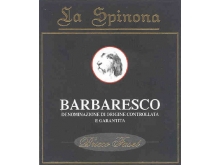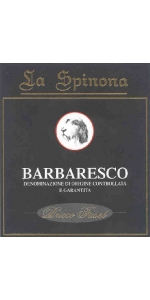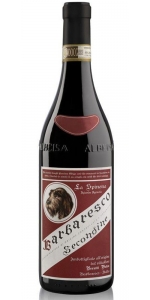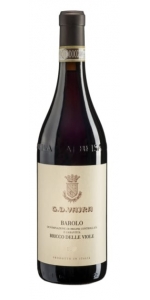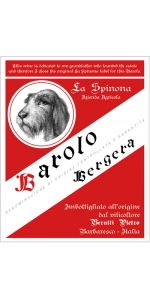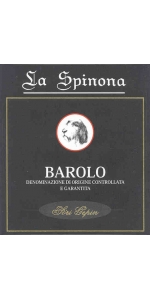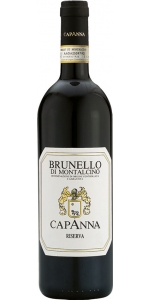Spinona Bricco Faset Barbaresco 2018
| Country: | Italy |
| Region: | Piemonte |
| Winery: | La Spinona |
| Grape Type: | Nebbiolo |
| Vintage: | 2018 |
| Bottle Size: | 750 ml |
Spinona Bricco Faset Barbaresco is made from 100 percent Nebbiolo.
This single-vineyard Barbaresco comes from Pietro Berutti's 8 hectares of coveted vineyards on the top of the historic hill, Faset. It is 270 meters above sea level with a south, south-east exposure. The vines are an average of 35 years old. Only organic farming practices are used. The natural fertilizer comes from the 100 head of cattle that they have and no herbicides or pesticides are used.
Barbaresco shows a deep ruby red color with garnet reflections. An intense bouquet with hints of ripe cherries, wild berries and spice. White pepper, licorice and mint blend with enticing floral notes. Mouth-filling and well-structured with a full, velvety body and an austere and long finish.
HARVEST: late October. The grapes are harvested by hand in perforated baskets to allow air to pass through the bunches. The pressing is soft. Cold maceration for 24 hours at 12°C (for certain years).
WINEMAKING: Soft pressing with an initial cold maceration on the skins for 24 hours at 12C. Specially selected yeasts are used. Fermentation takes place for 12 to 14 days in stainless steel at 28-29 °C under temperature controlled conditions. There is a pumping over on the skins. After malolactic fermentation, the wine is racked and goes through a delicate pressing to obtain only the best wine.
AGING : 12-15 months in large 25 hectolitre wooden barrels of Allier and Slavonian oak.
REFINING: in the bottle for 12-15 months in a temperature-controlled environment.
Excellent with game, red meats, truffle dishes and aged cheeses.
This single-vineyard Barbaresco comes from Pietro Berutti's 8 hectares of coveted vineyards on the top of the historic hill, Faset. It is 270 meters above sea level with a south, south-east exposure. The vines are an average of 35 years old. Only organic farming practices are used. The natural fertilizer comes from the 100 head of cattle that they have and no herbicides or pesticides are used.
Barbaresco shows a deep ruby red color with garnet reflections. An intense bouquet with hints of ripe cherries, wild berries and spice. White pepper, licorice and mint blend with enticing floral notes. Mouth-filling and well-structured with a full, velvety body and an austere and long finish.
Review:
La Spinona Barbaresco Secondine is made from 100 percent Nebbiolo.
This single-vineyard Barbaresco comes from his 3.5 hectares on the cru of Secondine. It is the commune of Barbaresco below the zone of Rabaja Basa and Paje and is where Gaja’s San Lorenzo is located. It is 230 meters above sea level with a southern exposure.
Excellent with game, red meats, truffle dishes and aged cheeses.
Color: Deep ruby red with a hint of garnet in the reflections.
Bouquet: Bright bouquet full of cherries, raspberries, licorice and floral notes.
Taste: Elegant and refined with delicate, soft tannins. It is fresh, velvety and extremely well balanced.
Review:
Aromas of wild red berry, blue flower, crushed mint and oak-driven spice come to the forefront. Reflecting the nose, the full-bodied, polished palate features juicy Morello cherry, crushed raspberry, star anise and spearmint alongside lithe tannins. It's balanced, with bright acidity and closes on a note of bitter almond.
-Wine Enthusiast 93 Points
La Spinona Barbaresco Secondine is made from 100 percent Nebbiolo.
This single-vineyard Barbaresco comes from his 3.5 hectares on the cru of Secondine. It is the commune of Barbaresco below the zone of Rabaja Basa and Paje and is where Gaja’s San Lorenzo is located. It is 230 meters above sea level with a southern exposure.
Excellent with game, red meats, truffle dishes and aged cheeses.
Color: Deep ruby red with a hint of garnet in the reflections.
Bouquet: Bright bouquet full of cherries, raspberries, licorice and floral notes.
Taste: Elegant and refined with delicate, soft tannins. It is fresh, velvety and extremely well balanced.
Review:
-James Suckling 94 Points
G.D. Vajra Bricco Delle Viole Barolo is made from 100 percent Nebbiolo.
The Barolo Bricco delle Viole shows the signature verticality of its vineyard. The wine is beautifully layered and - while restrained as it’s always the case in the youth of Bricco delle Viole - it also shows a complexity of layers with purple flowers, sweet spices and mineral tones. The palate is noble, with a refined acid spine and profound tannins that promise a long aging potential.
Among the historical vineyards of Barolo, Bricco delle Viole is the highest and the closest to the Alps. It rises from 400 to 480 meters above sea level, on the Western ridge of the village. Its name, “Hill of Violets”, originates from the flowers that blossom early here due to the perfect south exposure. Up above the fogs, Bricco delle Viole enjoys the earliest sunrise and the last sunset every day. Thanks to its vines dating back to 1949 and -now- 1931, a dramatic diuturnal temperature range and this pure light, Bricco delle Viole generates a sophisticated and profound Barolo DOCG of bright aromatics, chiseled tannins and subtle minerality. 2018 is a vintage that shows many nuances of Bricco delle Viole: beyond the signature verticality of this site, the wine offers high tones laced with mineral nuances and plenty of energy and youth.
Review:
The 2018 Barolo Bricco delle Viole is not super intense, but it is balanced in its own way. The wine is subdued but complete with softly yielding tannins to support an elegantly streamlined mouthfeel. Bricco delle Viole is a high and cool growing site in Barolo at 400 to 480 meters in elevation with characteristic Sant'Agata marl soils with fossils. The wine represents a selection of fruit from over seven hectares. With fermentation in steel tank and aging in large Slavonian oak, you are invited to a silky, lifted and beautifully delicate experience with an accessible personality.
-Wine Advocate 95 Points
Cellar Selection
An elegant version, this red features rose, black currant, cherry, mineral and a hint of eucalyptus aromas and flavors. Linear in profile, this is solidly built on a graceful frame, with finely woven tannins and vibrant acidity.
- Wine Spectator 95 Points
La Spinona Cru Bergera Barolo is made from 100 percent 100% Nebbiolo Lampia
The Beruttis bought 4 hectares in 1994 in the then relatively unknown zone of Novello which lies on the confines of Monforte and Barolo. A Sorì is an entirely south-facing vineyard. This Sori lies at 230 meters. It is named for the great grandfather that started the Barbaresco vineyards. The vines are an average of 40 years old. Bergera comes from the mid part of the vineyard and is dedicated to Pietro's grandfather who started the estate.
Brilliant deep ruby red with garnet reflections. Rich fruity bouquet with hints of cherries, violets liquorice and mint. Good structure with full, cherry-ripe flavors. The tannins are gentle and the spice subtle. It is an elegant wine of great finesse and drinkability. Excellent with wild game, roast, braised or stewed red meats, truffle dishes and aged cheeses.
La Spinona Sori Gepin Barolo is made from 100 percent Nebbiolo.
Color: Brilliant deep ruby red with garnet reflections.
Bouquet: Rich fruity bouquet with hints of violets , spice and mature berries.
Taste: Densely structured with full, complex flavors of ripened red fruits, wood and earth tones. A Huge wine of elegant proportions that become velvety and graceful with aging.
The Beruttis bought 4 hectares in 1994 in the then relatively unknown zone of Novello which lies on the confines of Monforte and Barolo. A Sorì is an entirely south-facing vineyard. This Sori lies at 230 meters. It is named for the great grandfather that started the Barbaresco vineyards. The vines are an average of 40 years old. The first vintage was the 1996.
The Spinona is a special breed of Piedmontese hunting Dog, which the Berutti’s raise. As the legend goes, this particular dog, Baica, received her place of honor on the label for an act of great heroism. She saved the Berutti’s only son from drowning in the irrigation lake when he was a baby. The son then became a veterinarian to save the dogs and later obtained a degree in agronomy to take care of the vineyards.
Brilliant deep ruby red with garnet reflections. Rich fruity bouquet with hints of violets, spice and mature berries. Densely structured with full, complex flavors of ripened red fruits, wood and earth tones. A huge wine of elegant proportions that becomes velvety and graceful with aging.
Review:
-James Suckling 93 Points
Spinona Bricco Faset Barbaresco is made from 100 percent Nebbiolo.
This single-vineyard Barbaresco comes from Pietro Berutti's 8 hectares of coveted vineyards on the top of the historic hill, Faset. It is 270 meters above sea level with a south, south-east exposure. The vines are an average of 35 years old. Only organic farming practices are used. The natural fertilizer comes from the 100 head of cattle that they have and no herbicides or pesticides are used.
Barbaresco shows a deep ruby red color with garnet reflections. An intense bouquet with hints of ripe cherries, wild berries and spice. White pepper, licorice and mint blend with enticing floral notes. Mouth-filling and well-structured with a full, velvety body and an austere and long finish.
HARVEST: late October. The grapes are harvested by hand in perforated baskets to allow air to pass through the bunches. The pressing is soft. Cold maceration for 24 hours at 12°C (for certain years).
WINEMAKING: Soft pressing with an initial cold maceration on the skins for 24 hours at 12C. Specially selected yeasts are used. Fermentation takes place for 12 to 14 days in stainless steel at 28-29 °C under temperature controlled conditions. There is a pumping over on the skins. After malolactic fermentation, the wine is racked and goes through a delicate pressing to obtain only the best wine.
AGING : 12-15 months in large 25 hectolitre wooden barrels of Allier and Slavonian oak.
REFINING: in the bottle for 12-15 months in a temperature-controlled environment.
Excellent with game, red meats, truffle dishes and aged cheeses.
This single-vineyard Barbaresco comes from Pietro Berutti's 8 hectares of coveted vineyards on the top of the historic hill, Faset. It is 270 meters above sea level with a south, south-east exposure. The vines are an average of 35 years old. Only organic farming practices are used. The natural fertilizer comes from the 100 head of cattle that they have and no herbicides or pesticides are used.
Barbaresco shows a deep ruby red color with garnet reflections. An intense bouquet with hints of ripe cherries, wild berries and spice. White pepper, licorice and mint blend with enticing floral notes. Mouth-filling and well-structured with a full, velvety body and an austere and long finish.
Review:
"Aromas of flowers, berries and sandalwood follow through to a medium body, fine tannins and a creamy, polished finish. So fine and pretty now. Why wait? Drink now."
- James Suckling (August 2022), 93 pts
The two Pietro Beruttis, grandfather and grandson, are well known and respected in the Barbaresco area and have received much acclaim both nationally and internationally for their wines. The Berutti’s estate consists of 22 hectares divided between four vineyard sites:
- La Spinona - 10 ha.
- L’Albina - 2.5 ha.
- La Ghiga - 5.5 ha.
- La Bergera - 4 ha.
Their best Barbaresco cru comes from the Faset vineyard area, of which Berutti owns the “Bricco” or crest of the vineyard. Only the owner of these coveted hilltop vineyards can use the designations “Bricco”,“Bric” on the label.
La Spinona uses only organic farming practices and is famous for their own production of natural fertilizer. They were one of the first Piedmont estates to obtain organic certification back in the 1980's.
The label of La Spinona is as famous as the wine. The Spinona is a special breed of Piedmontese hunting Dog, which the Berutti’s raise. As the legend goes, this particular dog, Baica, received her place of honor on the label for an act of great heroism. She saved the Berutti’s only son from drowning in the irrigation lake when he was a baby. The son then became a veterinarian to save the dogs and later obtained a degree in agronomy to take care of the vineyards.
The Beruttis produce Barbaresco, Barolo, Dolcetto, Barbera, Chardonnay & Nebbiolo delle Langhe.
Capanna Brunello di Montalcino Riserva 2015
TYPE: DOCG
BLEND: 100% Sangiovese carefully selected in the oldest vineyards and only of the best harvests.
VINIFICATION:
Alcoholic fermentation with maceration of the skins (30-35 days) at a controlled temperature and spontaneous malolactic fermentation, both in truncated cone-shaped Slavonian oak vats.
AGEING:
In Slavonian oak casks of 10 to 25 hl for over 40 months; followed by ageing in bottles for at least 15 months.
NOTES:
Colour: deep ruby red, strong, lively.
Bouquet: very intense and complex, fruity and spicy, with red fruit, jam and liquorice shades; great prospects of future development.
Taste: great structure in the acid-tannin components, well supported by the soft ones; extremely persistent.
Food pairings: roast red meats, game and very aged cheeses.
Review:
Powerful, sparkling garnet red. Rich, very appealing nose with notes of ripe raspberries and fresh plums, some liquorice and fine spice notes in the background. Grippy, fine-meshed tannin on the palate, builds up in many layers, salty, good tension, very long finish in the finish.
- Falstaff 98 Points
- back
Faust Cabernet Sauvignon is made from 85% Cabernet Sauvignon, complemented with Merlot, Petit Verdot and Cabernet Franc.
Cabernet’s classic aromas and flavors star in the 2022 Faust Napa Valley. Delicate violet notes lift the dark fruit on the nose—black currant and briary blackberry—layered with pungent forest botanicals, leafy tobacco, graphite, and toasted spice. The velvet of fine-textured tannins backs expressive red fruit flavors on a complex palate, both sweet and savory with mocha and minerality, juicy ripe fruit and freshness.
Review:
Deep garnet-purple colored, the 2022 Cabernet Sauvignon features scents of fresh blackcurrants, blueberries, and black raspberries, plus suggestions of pencil shavings and black olives. Full-bodied, the palate bursts with evocative black fruit flavors, supported by grainy tannins and bold freshness, finishing on a ferrous note. (LPB)
-Wine Independent 93 Points
Croix Senaillet Macon-Davaye is 100 percent Chardonnay.
Pale brilliant yellow color. Fresh nose of citrus fruits (lemon, grapefruit). Mineral and salty notes on the palate. Fresh, supple and harmonious in the mouth.
Produced from 7 different parcels of vines spread over 3.77 hectares, planted on clay and limestone based soils. Average age of the vine is 28 years. Careful vinification. Minimal intervention in the vinification process. Modern equipment (pneumatic press, thermo-regulated tanks). Each parcel is harvested at full maturity. Destemming, slow press, slow fermentation, malolactic fermentation, aging on the lees.
Excellent as an aperitif and pairs well with grilled fish and Asian food.

